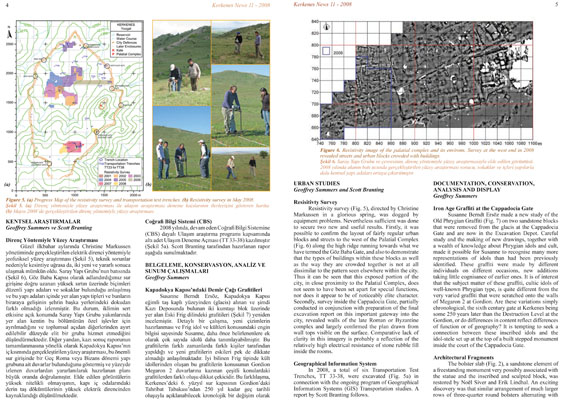| |
URBAN STUDIES
Geoffrey Summers and Scott Branting
Resisitivty Survey
Resistivity survey (Fig. 5), directed by Christine Markussen in a glorious spring, was dogged by equipment problems. Nevertheless suffi cient was done to secure two new and useful results. Firstly, it was possible to confi rm the layout of fairly regular urban blocks and streets to the west of the Palatial Complex (Fig. 6) along the high ridge running towards what we have termed the Göz Baba Gate, and also to demonstrate that the types of buildings within these blocks as well as the way they are crowded together is not at all dissimilar to the pattern seen elsewhere within the city. Thus it can be seen that this exposed portion of the city, in close proximity to the Palatial Complex, does not seem to have been set apart for special functions, nor does it appear to be of noticeably elite character. Secondly, survey inside the Cappadocia Gate, partially conducted in conjunction with preparation of the final excavation report on this important gateway into the city, revealed walls of the late Roman or Byzantine complex and largely confirmed the plan drawn from wall tops visible on the surface. Comparative lack of clarity in this imagery is probably a refl ection of the relatively high electrical resistance of stone rubble fill inside the rooms.
Geographical Information System
In 2008, a total of six Transportation Test Trenches, TT 33-38, were excavated (Fig. 5a) in connection with the ongoing program of Geographical Information Systems (GIS) Transportation studies. A report by Scott Branting follows.
DOCUMENTATION, CONSERVATION, ANALYSIS AND DISPLAY
Geoffrey Summers
Iron Age Graffi ti at the Cappadocia Gate Susanne Berndt Ersöz made a new study of the Old Phrygian Graffi ti (Fig. 7) on two sandstone blocks that were removed from the glacis at the Cappadocia Gate and are now in the Excavation Depot. Careful study and the making of new drawings, together with a wealth of knowledge about Phrygian idols and cult, made it possible for Susanne to recognise many more representations of idols than had been previously identifi ed. These graffi ti were made by different individuals on different occasions, new additions taking little cognisance of earlier ones. It is of interest that the subject matter of these graffi ti, cultic idols of well-known Phrygian type, is quite different from the very varied graffi ti that were scratched onto the walls of Megaron 2 at Gordion. Are these variations simply chronological, the sixth century gate at Kerkenes being some 250 years later than the Destruction Level at the Gordion, or do differences in content refl ect differences of function or of geography? It is tempting to seek a connection between these inscribed idols and the idol-stele set up at the top of a built stepped monument inside the court of the Cappadocia Gate.
Architectural Fragments
The bolster slab (Fig. 2), a sandstone element of a freestanding monument very possibly associated with the statue and the inscribed and sculpted block, was restored by Noël Siver and Erik Lindhal. An exciting discovery was that similar arrangement of much larger rows of three-quarter round bolsters alternating with |



